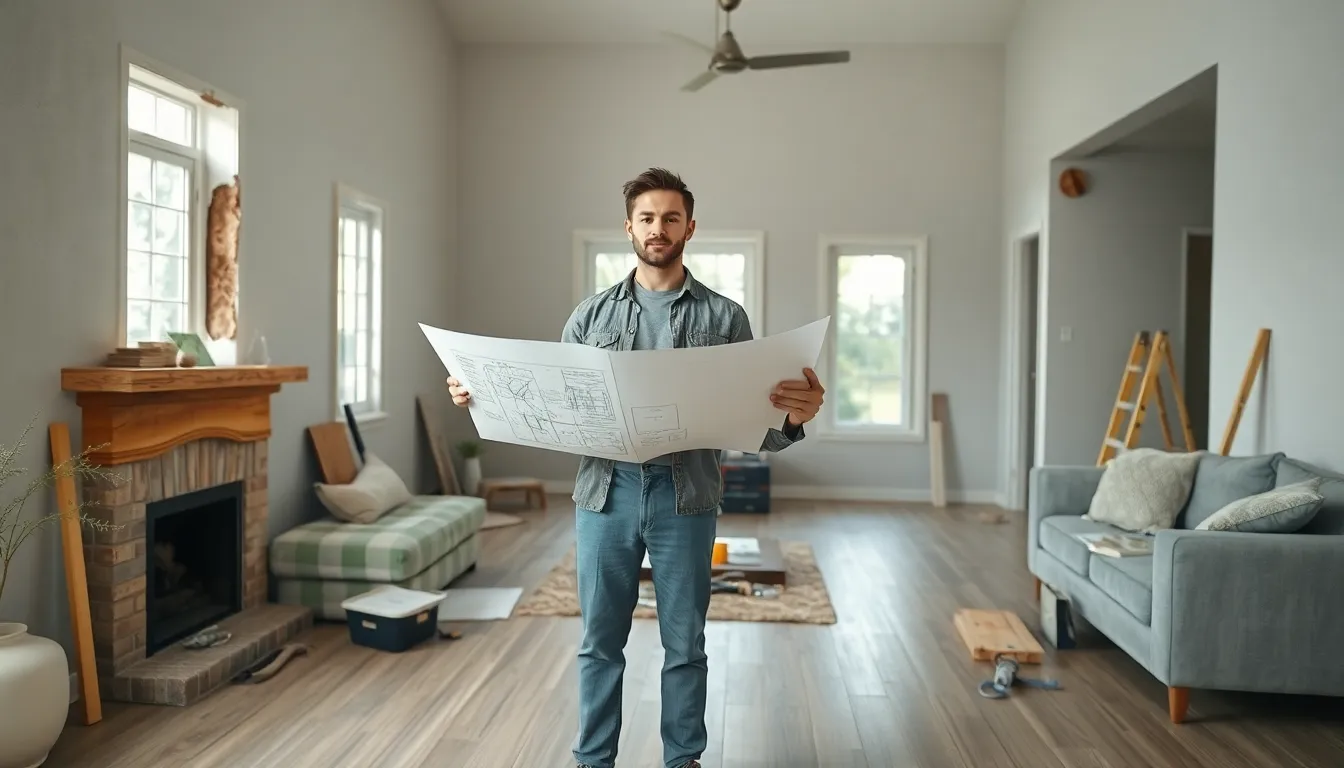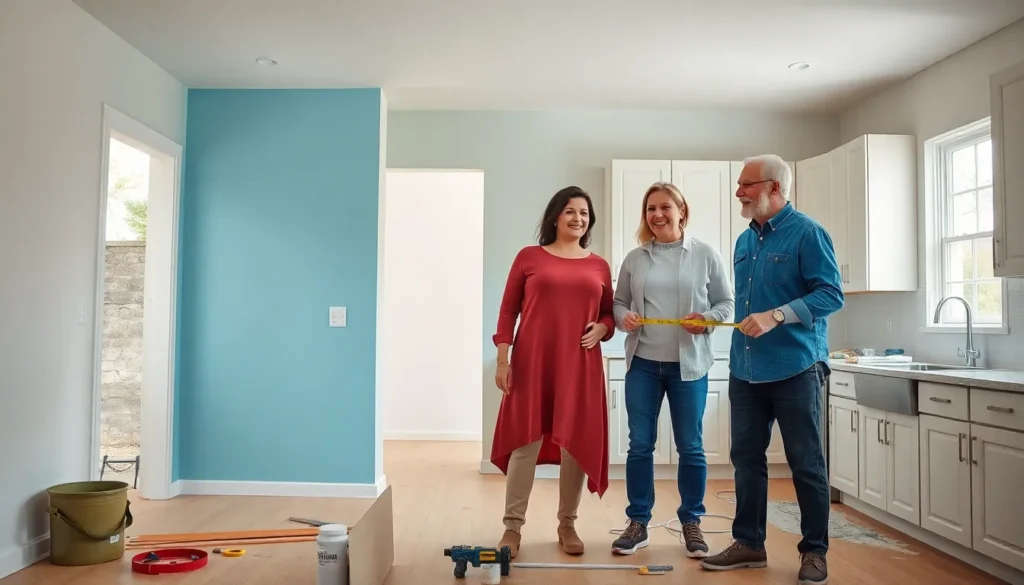Home renovation can transform a house into a dream living space. Whether it’s a small update or a complete overhaul, the process offers homeowners a chance to enhance both aesthetics and functionality. With the right approach, renovations can increase property value and create a more enjoyable environment.
As trends evolve, so do the possibilities for home improvement. From modernizing kitchens to creating cozy outdoor spaces, the options are endless. Homeowners often find themselves navigating a maze of decisions, from choosing styles to managing budgets. Understanding the essentials of home renovation is crucial for anyone looking to embark on this exciting journey.
Table of Contents
ToggleOverview of Home Renovation
Home renovation encompasses a variety of projects aimed at improving a property’s appearance and functionality. Homeowners engage in renovations to update visual elements like paint, flooring, and fixtures, or to enhance structural features such as walls and roofs. The intention behind renovation projects often focuses on increasing property value, optimizing living space, and adapting to changing needs.
Understanding renovation types is crucial. Minor renovations, like kitchen updates or bathroom remodels, generally involve cosmetic changes that refresh existing spaces. Major renovations, such as adding rooms or structural modifications, require extensive planning and financial investment. Each type presents unique challenges and rewards that require consideration.
Budgeting plays an essential role in the renovation process. Homeowners typically allocate funds for materials, labor, permits, and unexpected expenses. It’s advisable to set aside at least 10-15% of the overall budget for contingencies. Researching contractors and suppliers also provides insight into pricing and available options.
Lastly, timing impacts the renovation outcome. Seasonal factors can affect schedules and costs. For instance, spring and summer often see increased labor availability but may involve higher material prices. Planning renovation projects around these factors ensures a smoother, more efficient process.
Planning Your Home Renovation

Effective planning is key to a successful home renovation. Homeowners must consider their budget and timeline to ensure a smooth process.
Setting a Budget
Budgeting starts with determining the total funds available for the renovation. Homeowners often allocate 10-15% of the total budget for unexpected expenses. Key budget components include:
- Materials: Costs for items like flooring, paint, and fixtures.
- Labor: Charges for professional services needed for installation or construction.
- Permits: Fees associated with obtaining necessary permits for specific projects.
- Contingency: A reserve for unexpected costs.
Homeowners should conduct thorough research to obtain estimates and quotes, ensuring a realistic budget that covers all aspects of the renovation.
Creating a Timeline
Establishing a timeline helps manage expectations and coordinate the renovation process. Homeowners typically need to consider the following elements:
- Project Scope: The size and complexity of the renovations significantly influence the timeline.
- Seasonal Factors: Some projects may require specific weather conditions, impacting scheduling.
- Permitting Process: Applying for and receiving permits can add time to the overall project.
Setting milestones helps track progress and stay organized. Clear communication with contractors also plays a crucial role in adhering to the timeline, ensuring timely completion of the renovation.
Popular Home Renovation Projects
Homeowners often choose specific projects to enhance their spaces. Popular renovations focus on improving functionality and aesthetics across various areas of the home.
Kitchen Renovations
Kitchen renovations frequently involve updating cabinets, countertops, and appliances. He or she might opt for a modern design, featuring open floor plans and energy-efficient models. Popular materials include quartz countertops and hardwood cabinets, which add both style and durability. The integration of smart technology, such as smart refrigerators and automated lighting systems, can significantly enhance kitchen functionality while attracting potential buyers.
Bathroom Upgrades
Bathroom upgrades commonly focus on improving comfort and efficiency. Homeowners may install new fixtures, such as low-flow toilets and energy-efficient showerheads, which can conserve water and reduce utility bills. Upgrading vanities with modern designs and high-quality materials often creates a more appealing environment. Additionally, adding storage solutions like built-in shelves and cabinetry maximizes space, enhancing both style and convenience. Popular trends include incorporating spa-like elements, such as soaking tubs and heated floors, which elevate the relaxation experience.
Choosing the Right Contractors
Choosing the right contractors plays a crucial role in the success of a home renovation project. Homeowners should prioritize qualifications, experience, and reputation when selecting contractors for their renovations.
- Research Credentials: Homeowners should verify the licenses, insurance, and certifications of potential contractors. These credentials ensure contractors meet industry standards and legal requirements.
- Solicit References: Homeowners must request references from previous clients. Speaking directly with former clients provides insights into the contractor’s work quality and professionalism.
- Review Portfolios: Homeowners should examine contractors’ portfolios to evaluate previous projects. A thorough review highlights styles, finishes, and workmanship, helping homeowners gauge suitability for their renovation vision.
- Obtain Multiple Estimates: Homeowners benefit from obtaining at least three estimates for their project. Comparing quotes helps clarify pricing structures and unveils potential hidden costs.
- Assess Communication Skills: Homeowners must assess how effectively contractors communicate. Clear communication fosters collaboration and ensures expectations are understood and met throughout the renovation process.
- Confirm Availability: Homeowners should confirm contractors’ availability to start and complete the project. Understanding timelines ensures the renovation aligns with the homeowner’s schedule and goals.
- Understand Contract Terms: Homeowners must review all contract terms before signing. A clear understanding of payment schedules, project scope, and timeline reduces the chances of misunderstandings during the renovation.
Selecting the right contractors significantly impacts the quality and efficiency of the renovation, ensuring the final outcome meets the homeowner’s aspirations.
Design Trends in Home Renovation
Current design trends in home renovation highlight innovation, sustainability, and personalization. Homeowners increasingly seek to create spaces that are not only visually appealing but also functional and environmentally friendly.
Open Floor Plans
Open floor plans remain popular, promoting fluidity and connection among living spaces. This layout enhances natural light and creates a sense of spaciousness. Homeowners often combine kitchens, dining areas, and living rooms to foster interaction and a communal atmosphere.
Sustainable Materials
Sustainability influences material selection, with homeowners opting for eco-friendly options. Bamboo flooring, recycled glass countertops, and reclaimed wood furniture reflect environmental consciousness. Such materials reduce carbon footprints while adding unique character to homes.
Smart Home Technology
Smart home technology integrates seamlessly into renovation projects, enhancing convenience and efficiency. Automated lighting, smart thermostats, and security systems allow homeowners to control their environments remotely. This trend supports energy savings and improves overall home management.
Biophilic Design
Biophilic design emphasizes connecting indoor spaces with nature. Incorporating plants, natural lighting, and organic materials cultivates a calming atmosphere. Features such as living walls and large windows enhance visual appeal and improve air quality.
Minimalist Aesthetics
Minimalist aesthetics prioritize simplicity and functionality. Clean lines, neutral color palettes, and uncluttered spaces define this trend. Homeowners choose fewer, high-quality furnishings to maintain serenity and focus on essential items.
Multifuntional Spaces
Multifunctional spaces accommodate various activities, reflecting changing lifestyles. Homeowners design offices that double as guest rooms or create versatile dining areas. This adaptability maximizes square footage and meets diverse needs.
Outdoor Living Spaces
Outdoor living spaces gain popularity as homeowners extend their home experiences to the outdoors. Features such as patios, outdoor kitchens, and fire pits encourage relaxation and entertainment. This trend capitalizes on climate-friendly designs and enhances property value.
Vintage and Retro Elements
Vintage and retro design elements re-emerge in home renovation, adding character and nostalgia. Homeowners incorporate mid-century modern furniture, retro light fixtures, and reclaimed accessories to evoke charm. These elements often blend seamlessly with contemporary designs.
Customization and Personalization
Customization allows homeowners to express their individuality. Unique fixtures, personalized color schemes, and bespoke furniture pieces cater to personal aesthetics. This trend fosters a sense of ownership and connection to the space.
Adapting to these design trends in home renovation not only enhances comfort and functionality but also increases property value. Homeowners benefit from staying informed about evolving preferences and incorporating them into their renovation plans.
Home renovation opens up a world of possibilities for enhancing a living space. By understanding the various aspects of renovation projects homeowners can make informed decisions that align with their goals. Whether opting for minor updates or significant overhauls the right planning and execution can lead to impressive transformations.
Choosing qualified contractors and staying updated on design trends can further elevate the renovation experience. Ultimately a well-executed renovation not only boosts property value but also creates a more enjoyable and functional environment. Embracing the journey of home renovation can lead to a space that truly reflects personal style and meets evolving needs.



